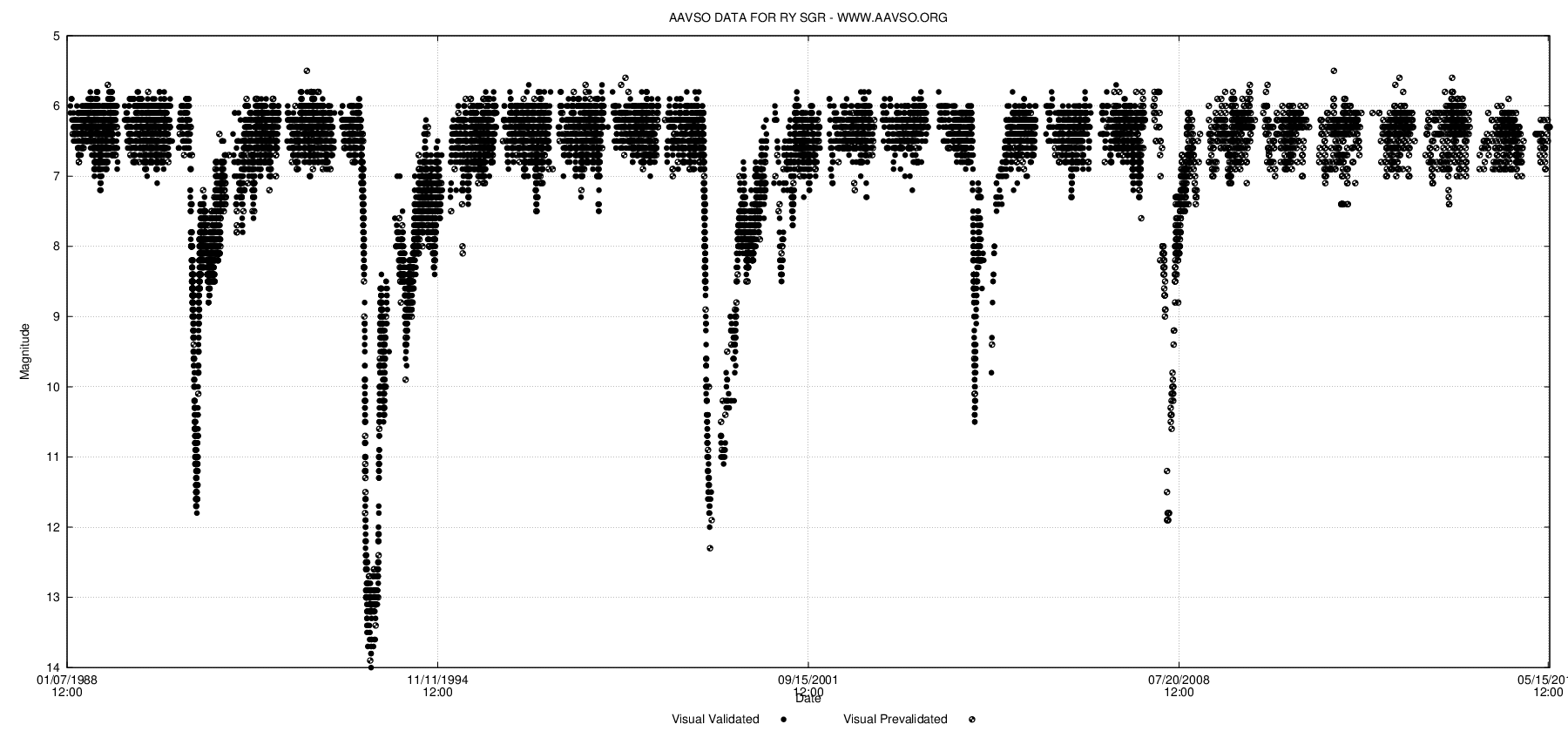RY Sagittarii on:
[Wikipedia]
[Google]
[Amazon]
RY Sagittarii is a
 Colonel Ernest Elliott Markwick first came across what became known as RY Sagittarii during searches for variable stars while posted in Gibraltar. He recorded it dimming from magnitude 7 in July 1893 to fainter than 11 by 23 October that year, and brightening to magnitude 6.4 by November 1894.
Colonel Ernest Elliott Markwick first came across what became known as RY Sagittarii during searches for variable stars while posted in Gibraltar. He recorded it dimming from magnitude 7 in July 1893 to fainter than 11 by 23 October that year, and brightening to magnitude 6.4 by November 1894.
yellow supergiant
A yellow supergiant (YSG) is a star, generally of spectral type F or G, having a supergiant luminosity class (e.g. Ia or Ib). They are stars that have evolved away from the main sequence, expanding and becoming more luminous.
Yellow supergiants ...
and an R Coronae Borealis type variable star
A variable star is a star whose brightness as seen from Earth (its apparent magnitude) changes with time. This variation may be caused by a change in emitted light or by something partly blocking the light, so variable stars are classified as ...
in the constellation
A constellation is an area on the celestial sphere in which a group of visible stars forms Asterism (astronomy), a perceived pattern or outline, typically representing an animal, mythological subject, or inanimate object.
The origins of the e ...
Sagittarius. Although it ostensibly has the spectrum of a G-type star, it differs markedly from most in that it has almost no hydrogen and much carbon.
Discovery
 Colonel Ernest Elliott Markwick first came across what became known as RY Sagittarii during searches for variable stars while posted in Gibraltar. He recorded it dimming from magnitude 7 in July 1893 to fainter than 11 by 23 October that year, and brightening to magnitude 6.4 by November 1894.
Colonel Ernest Elliott Markwick first came across what became known as RY Sagittarii during searches for variable stars while posted in Gibraltar. He recorded it dimming from magnitude 7 in July 1893 to fainter than 11 by 23 October that year, and brightening to magnitude 6.4 by November 1894. Edward Charles Pickering
Edward Charles Pickering (July 19, 1846 – February 3, 1919) was an American astronomer and physicist and the older brother of William Henry Pickering. Along with Carl Vogel, Pickering discovered the first spectroscopic binary stars. He wrote ''E ...
wrote that it was a "remarkable object", and "nearly got away". The spectrum was first noted to be peculiar at the time, and by 1953 it was classified as a R Coronae Borealis variable, along with a handful of other stars.
Mystified by its origins, Danziger postulated possible explanations as forming from a helium cloud, an aged star that had exhausted its hydrogen, or a star that had somehow thrown off its hydrogen envelope, though noted there was no evidence of such an envelope. He conceded that knowledge of star evolution was not advanced enough to come up with an explanation.
Variability
It is one of the three brightest R Coronae Borealis stars visible to Earth observers, along withR Coronae Borealis
R Coronae Borealis is a low-mass yellow supergiant star in the constellation of Corona Borealis. It is the prototype of the R Cor Bor class of variable stars, which fade by several magnitudes at irregular intervals. R Coronae Boreali ...
and V854 Centauri, and the brightest in the southern hemisphere. It is also a pulsating variable, with a semiregular period of 38 days. Its light curve has been studied for over a hundred years and is typical for the class, characterised by a sudden drop in brightness of several magnitudes over a few weeks before gradually brightening over the following several months. The timing between these dimmings is irregular. The cause of the drop in magnitude is the presence of dust clouds of carbon obscuring (and most likely ejected from) the star, though the mechanism how this might occur is not known. Extensive clouds have been detected with ESO's Very Large Telescope Interferometer.
Properties
The star is so remote that its parallax, distance and hence luminosity were impossible to calculate with any accuracy. TheHipparcos
''Hipparcos'' was a scientific satellite of the European Space Agency (ESA), launched in 1989 and operated until 1993. It was the first space experiment devoted to precision astrometry, the accurate measurement of the positions of celestial obj ...
satellite calculated its parallax at 1.29 milliarcseconds, yielding a distance of from Earth
Earth is the third planet from the Sun and the only astronomical object known to harbor life. While large volumes of water can be found throughout the Solar System, only Earth sustains liquid surface water. About 71% of Earth's surfa ...
. Its parallax from the Gaia EDR3
The ''Gaia'' catalogues are star catalogues created using the results obtained by ''Gaia'' space telescope.
The catalogues are released in stages that will contain increasing amounts of information; the early releases also miss some stars, especia ...
is much smaller at , indicating a much larger distance consistent with non-parallax estimates of the distance. The distance derived indirectly by comparison with similar stars, is around 2,000 parsecs. Its effective temperature has been calculated at 7,250 K and its size at based on an assumed luminosity of .
References
{{DEFAULTSORT:RY Sagittarii Durchmusterung objects 180093 094730 7296 Sagittarii, RY R Coronae Borealis variables Sagittarius (constellation)